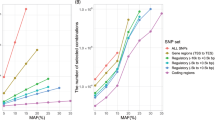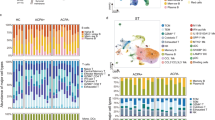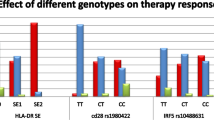Abstract
It has repeatedly been suggested that the development of complex diseases can be elucidated by gene–gene interactions. Recently, we found that HTR2A, a member of the serotonin receptor family, is associated with rheumatoid arthritis (RA). This study was aimed to investigate the possibility of a gene–gene interaction between HTR2A and the major genetic risk factor for RA, HLA-DRB1 shared epitope (SE) alleles. We studied 4095 RA cases and 3223 controls from three different populations – from Sweden, the United States and the Netherlands – to test for interaction between the protective HTR2A haplotype and HLA-DRB1 SE alleles. Further, we analyzed mRNA and/or protein expression of HTR2A and HLA-DR in biopsy samples and in synovial fibroblasts from RA patients. The interaction was defined as departure from additivity of effects using attributable proportion due to interaction. First, we could demonstrate and further replicate an interaction between a protective haplotype in HTR2A and HLA-DRB1 SE alleles regarding risk of developing autoantibody-positive RA. Second, we could show that both genes are constitutively expressed in fibroblasts from synovial tissue of RA patients, and, by double immunofluorescence staining, we demonstrated that these two proteins are colocalized in these cells. In conclusion, our data demonstrate a statistical interaction between HTR2A and HLA-DRB1 SE alleles and colocalization of the product of these two genes in inflamed synovial tissue, which suggest a possible biological relationship between these two proteins. This finding may lead to the development of treatment based on enhancing the protective features of 5-HT2A in individuals with a certain HLA genotype.
Similar content being viewed by others
Log in or create a free account to read this content
Gain free access to this article, as well as selected content from this journal and more on nature.com
or
References
Stastny P : Association of the B-cell alloantigen DRw4 with rheumatoid arthritis. N Engl J Med 1978; 298: 869–871.
Begovich AB, Carlton VE, Honigberg LA et al: A missense single-nucleotide polymorphism in a gene encoding a protein tyrosine phosphatase (PTPN22) is associated with rheumatoid arthritis. Am J Hum Genet 2004; 75: 330–337.
Remmers EF, Plenge RM, Lee AT et al: STAT4 and the risk of rheumatoid arthritis and systemic lupus erythematosus. N Engl J Med 2007; 357: 977–986.
Plenge RM, Seielstad M, Padyukov L et al: TRAF1-C5 as a risk locus for rheumatoid arthritis – a genomewide study. N Engl J Med 2007; 357: 1199–1209.
Kurreeman FA, Padyukov L, Marques RB et al: A candidate gene approach identifies the TRAF1/C5 region as a risk factor for rheumatoid arthritis. PLoS Med 2007; 4: e278.
Raychaudhuri S, Remmers EF, Lee AT et al: Common variants at CD40 and other loci confer risk of rheumatoid arthritis. Nat Genet 2008; 40: 1216–1223.
Kallberg H, Padyukov L, Plenge RM et al: Gene-gene and gene-environment interactions involving HLA-DRB1, PTPN22, and smoking in two subsets of rheumatoid arthritis. Am J Hum Genet 2007; 80: 867–875.
Padyukov L, Silva C, Stolt P, Alfredsson L, Klareskog L : A gene-environment interaction between smoking and shared epitope genes in HLA-DR provides a high risk of seropositive rheumatoid arthritis. Arthritis Rheum 2004; 50: 3085–3092.
Abdouh M, Storring JM, Riad M et al: Transcriptional mechanisms for induction of 5-HT1A receptor mRNA and protein in activated B and T lymphocytes. J Biol Chem 2001; 276: 4382–4388.
Sternberg EM, Trial J, Parker CW : Effect of serotonin on murine macrophages: suppression of Ia expression by serotonin and its reversal by 5-HT2 serotonergic receptor antagonists. J Immunol 1986; 137: 276–282.
Hoyer D, Hannon JP, Martin GR : Molecular, pharmacological and functional diversity of 5-HT receptors. Pharmacol Biochem Behav 2002; 71: 533–554.
Idzko M, Panther E, Stratz C et al: The serotoninergic receptors of human dendritic cells: identification and coupling to cytokine release. J Immunol 2004; 172: 6011–6019.
Guillet-Deniau I, Burnol AF, Girard J : Identification and localization of a skeletal muscle secrotonin 5-HT2A receptor coupled to the Jak/STAT pathway. J Biol Chem 1997; 272: 14825–14829.
Cloez-Tayarani I, Petit-Bertron AF, Venters HD, Cavaillon JM : Differential effect of serotonin on cytokine production in lipopolysaccharide-stimulated human peripheral blood mononuclear cells: involvement of 5-hydroxytryptamine2A receptors. Int Immunol 2003; 15: 233–240.
Yu B, Becnel J, Zerfaoui M, Rohatgi R, Boulares AH, Nichols CD : Serotonin 5-hydroxytryptamine(2A) receptor activation suppresses tumor necrosis factor-alpha-induced inflammation with extraordinary potency. J Pharmacol Exp Ther 2008; 327: 316–323.
Kling A, Seddighzadeh M, Arlestig L, Alfredsson L, Rantapaa-Dahlqvist S, Padyukov L : Genetic variations in the serotonin 5-HT2A receptor gene (HTR2A) are associated with rheumatoid arthritis. Ann Rheum Dis 2008; 67: 1111–1115.
Plenge RM, Padyukov L, Remmers EF et al: Replication of putative candidate-gene associations with rheumatoid arthritis in >4,000 samples from North America and Sweden: association of susceptibility with PTPN22, CTLA4, and PADI4. Am J Hum Genet 2005; 77: 1044–1060.
Mattey DL, Dawes PT, Clarke S et al: Relationship among the HLA-DRB1 shared epitope, smoking, and rheumatoid factor production in rheumatoid arthritis. Arthritis Rheum 2002; 47: 403–407.
Klareskog L, Stolt P, Lundberg K et al: A new model for an etiology of rheumatoid arthritis: smoking may trigger HLA-DR (shared epitope)-restricted immune reactions to autoantigens modified by citrullination. Arthritis Rheum 2006; 54: 38–46.
van Oosterhout M, Bajema I, Levarht EW, Toes RE, Huizinga TW, van Laar JM : Differences in synovial tissue infiltrates between anti-cyclic citrullinated peptide-positive rheumatoid arthritis and anti-cyclic citrullinated peptide-negative rheumatoid arthritis. Arthritis Rheum 2008; 58: 53–60.
van Dongen H, van Aken J, Lard LR et al: Efficacy of methotrexate treatment in patients with probable rheumatoid arthritis: a double-blind, randomized, placebo-controlled trial. Arthritis Rheum 2007; 56: 1424–1432.
Arnett FC, Edworthy SM, Bloch DA et al: The American Rheumatism Association 1987 revised criteria for the classification of rheumatoid arthritis. Arthritis Rheum 1988; 31: 315–324.
van Aken J, van Bilsen JH, Allaart CF, Huizinga TW, Breedveld FC : The Leiden Early Arthritis Clinic. Clin Exp Rheumatol 2003; 21: S100–S105.
Jawaheer D, Seldin MF, Amos CI et al: A genomewide screen in multiplex rheumatoid arthritis families suggests genetic overlap with other autoimmune diseases. Am J Hum Genet 2001; 68: 927–936.
Jawaheer D, Lum RF, Amos CI, Gregersen PK, Criswell LA : Clustering of disease features within 512 multicase rheumatoid arthritis families. Arthritis Rheum 2004; 50: 736–741.
Ronnelid J, Wick MC, Lampa J et al: Longitudinal analysis of citrullinated protein/peptide antibodies (anti-CP) during 5 year follow up in early rheumatoid arthritis: anti-CP status predicts worse disease activity and greater radiological progression. Ann Rheum Dis 2005; 64: 1744–1749.
Huizinga TW, Amos CI, van der Helm-van Mil AH et al: Refining the complex rheumatoid arthritis phenotype based on specificity of the HLA-DRB1 shared epitope for antibodies to citrullinated proteins. Arthritis Rheum 2005; 52: 3433–3438.
Ulfgren AK, Lindblad S, Klareskog L, Andersson J, Andersson U : Detection of cytokine producing cells in the synovial membrane from patients with rheumatoid arthritis. Ann Rheum Dis 1995; 54: 654–661.
Westman M, Korotkova M, af Klint E et al: Expression of microsomal prostaglandin E synthase 1 in rheumatoid arthritis synovium. Arthritis Rheum 2004; 50: 1774–1780.
Stephens M, Donnelly P : A comparison of bayesian methods for haplotype reconstruction from population genotype data. Am J Hum Genet 2003; 73: 1162–1169.
Rothman K : Epidemiology. An Introduction. New York: Oxford University Press, 2002.
Andersson T, Alfredsson L, Kallberg H, Zdravkovic S, Ahlbom A : Calculating measures of biological interaction. Eur J Epidemiol 2005; 20: 575–579.
Fleiss JL : The statistical basis of meta-analysis. Stat Methods Med Res 1993; 2: 121–145.
Norton N, Owen MJ : HTR2A: association and expression studies in neuropsychiatric genetics. Ann Med 2005; 37: 121–129.
Eaton WW, Hayward C, Ram R : Schizophrenia and rheumatoid arthritis: a review. Schizophr Res 1992; 6: 181–192.
Wright P, Donaldson PT, Underhill JA, Choudhuri K, Doherty DG, Murray RM : Genetic association of the HLA DRB1 gene locus on chromosome 6p21.3 with schizophrenia. Am J Psychiatry 1996; 153: 1530–1533.
Sasaki T, Matsushita M, Nanko S, Fukuda R, Kennedy JL, Tokunaga K : Schizophrenia and the HLA-DRB1 gene in the Japanese population. Am J Psychiatry 1999; 156: 771–773.
Acknowledgements
The EIRA study was supported by grants from the Swedish Medical Research Council, Swedish Council for Working life and Social Research, King Gustaf V's 80-year foundation, the Swedish Rheumatism Foundation, Stockholm County Council, the insurance company AFA and Combine (Vinnova). We thank the RA patients and controls for participating in the study; Eva Jemseby, Marie-Louise Serra, Lena Nise and Camilla Bengtsson for invaluable contributions to the collection of data and maintenance of the EIRA database; as well as Johan Rönnelid (Unit of Clinical Immunology Uppsala University/Akademiska Hospital) and Hiba Mahdi (Karolinska University Hospital) for performing the analysis of anti-CCP. The Leiden EAC study was supported by grants from the Duthch Arthritis foundation, the European program grant FP6 AutoCure and FP1 Masterswitch, as well as a grant from the center for Medical System Biology within the framework of the Netherlands Genomic Initiative. We thank Peter Gregersen and the NARAC investigators for providing continuing access to genotyping data on the NARAC cohort; the NARAC study is supported by grants from the National Institutes of Health RO1-AR44422 and NO1-AR-2-2263.
Author information
Authors and Affiliations
Corresponding author
Ethics declarations
Competing interests
The authors declare no conflict of interest.
Rights and permissions
About this article
Cite this article
Seddighzadeh, M., Korotkova, M., Källberg, H. et al. Evidence for interaction between 5-hydroxytryptamine (serotonin) receptor 2A and MHC type II molecules in the development of rheumatoid arthritis. Eur J Hum Genet 18, 821–826 (2010). https://doi.org/10.1038/ejhg.2010.12
Received:
Accepted:
Published:
Issue date:
DOI: https://doi.org/10.1038/ejhg.2010.12
Keywords
This article is cited by
-
New polymorphisms associated with response to anti-TNF drugs in patients with moderate-to-severe plaque psoriasis
The Pharmacogenomics Journal (2018)
-
Genetic variation in the serotonin receptor gene affects immune responses in rheumatoid arthritis
Genes & Immunity (2013)



